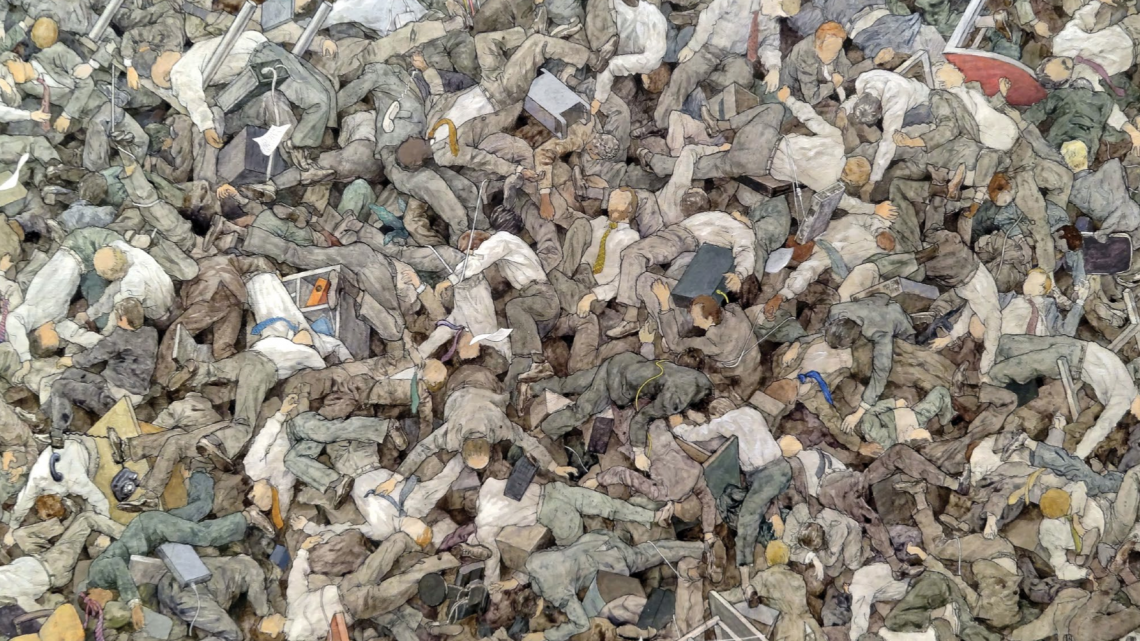A while ago I came across Makoto Aida while changing trains at my station in the Yokohama suburbs. He was wearing his trademark green camouflage jacket. His gaze lingered a second longer than usual on my face, probably because I was staring at him. I don’t think he remembered me from the last time we had met, at the crowded press conference for his blockbuster exhibition at the Mori Museum of Art. I had heard he lived in this area, so I got ready for our next chance encounter. Luckily I didn’t have to wait too long: A few days ago I went to the fake French bakery Vie de France, just outside the station, and there he was, sitting at a small table near the entrance, coffee cup in his hands, sporting his usual half-asleep look and a beard full of bread crumbs. I grabbed something to eat and just sat in front of him, waiting for his WTF reaction. That didn’t materialize.
I like Aida because he had to earn his fame. He is known for his depictions of the erotic and grotesque, be it young girls, war, or other controversial subjects. In the past this earned him the reputation of being an artist “too hot to handle.” As a consequence he struggled for many years while less engaging Japanese artists became international superstars. Now his time has come, but he seems to take even this newfound success in stride.
Born in 1965, the handsome-looking Aida has always had a knack for going against the flow of artistic coolness, mixing traditional technique and contemporary themes, East and West, while choosing often bizarre and uncomfortable subjects. New Yorkers had a couple of close encounters with his work, first in 2003 at the Whitney Museum of American Art (The American Effect: Global Perspectives on the United States, 1990-2003), then in 2011 at the Japan Society (Bye Bye Kitty!!! Between Heaven and Hell in Contemporary Japanese Art).
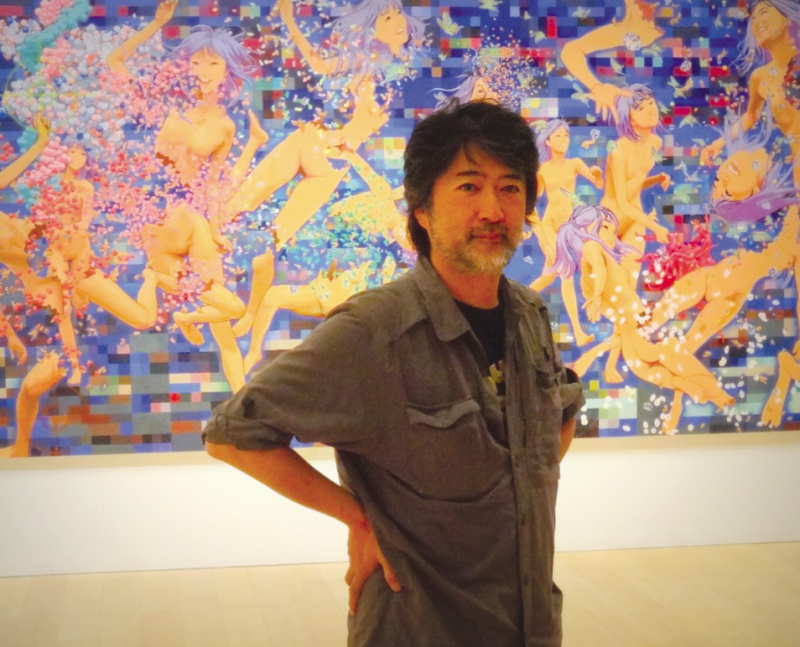
Makoto Aida photographed by Gianni Simone.
“Do you speak Japanese? Because I can’t speak English.”
That’s the same phrase you opened your recent TEDxTokyo talk with.
Yes, I think among Japanese contemporary artists it’s only [photographer] Nobuyoshi Araki and me who can’t speak English (laughs) so I was very surprised when TEDx invited me to talk in front of everybody. Language aside, I don’t know what TEDx wanted from me. Their slogan is “ideas worth spreading,” and I don’t have any ideas to spread. This reminds me of when I was interviewed by a newspaper and they asked me to write a motto or something. Now, as an artist I’m very inconsistent, always jumping from one subject or technique to another, so eventually I wrote the word tekito which has several meanings, like “random,” “whatever works,” or “let things work out naturally,” which summarizes my life and work quite well.
One of the works you created for the Mori retrospective is the Non Thinker, a statue made of FRP, which obviously apes Auguste Rodin’s The Thinker. In typical Japanese fashion, you turned it into Onigiri Man (Rice Ball Man), a sort of slacker superhero. Is this work part of your tekito philosophy?
This is a character that I created to explore my desire to lead an idle life. He actually looks like he is sitting on top of a huge turd (laughs). I think when people go to the toilet they may think about anything. Or maybe not. Maybe they are just living in a state of bliss. I guess I’m more like that. I don’t really like the hectic kind of life you can find in Tokyo or New York. I prefer a more relaxed pace of life. That relaxed, idealistic life is inside me.
In Ash-Colored Mountains you have gone so far as to paint thousands of dead office workers piled atop one another in mountainous heaps. Is this intended as another comment on modern life?
I guess you are right. Since I was a kid I always doubted that the way people work and live today is the right way. This work came from that doubt and it’s also one of the reasons why I’m an artist. This said, I really don’t know why they are there. In my imagination they fall from the sky one by one and pile up like sand, forming huge mountains like this.
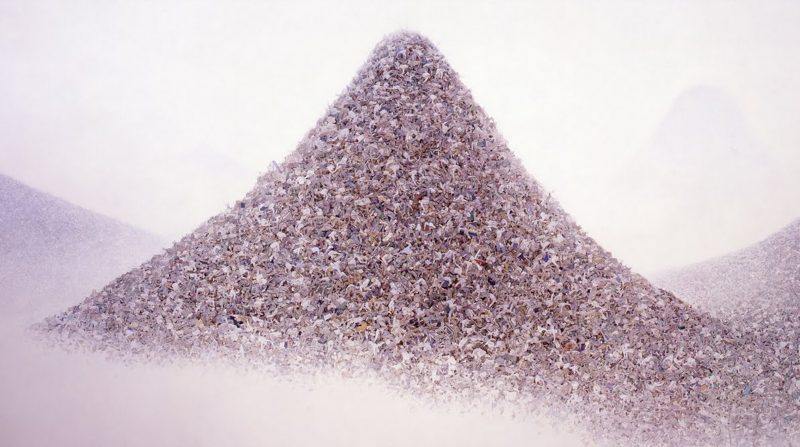
Makoto Aida, “Ash Color Mountains,” 2009-11. Acrylic on canvas, 300 x 700cm. Taguchi Art Collection of Cooperation: Watanabe Atsushi.
Now that you are approaching fifty, don’t you find it hard to make those huge paintings?
Yes, I guess so. They’re all so large in size that they couldn’t be shown in a regular gallery. And as I have to climb up and down a ladder all the time to paint these big pictures, they take a toll on my body. I’m actually just one step away now from old age. My body still moves quite well, but I have the premonition this will become too physically demanding before long . . . It’s already quite exhausting, though (laughs). Anyhow, realistically, I’m thinking I may have about ten years more of painting such crazy big pictures.
You keep stressing the fact that people abroad don’t necessarily need to understand your works.
Again, I think it’s a problem of language. As I don’t speak English, unless a foreigner speaks Japanese fluently I have difficulty figuring out what the hell they are thinking. Another problem is that even though I consider myself to be a contemporary artist and have studied the likes of Duchamp, Beuys, Warhol, etc. I’ve never really been a fan of any foreign contemporary artist. In my college days there wasn’t a single one that I respected from the bottom of my heart. So whenever I’m asked about my influences I mention novelist Yukio Mishima or other people who have nothing to do with art. That’s why I feel like my work doesn’t make much sense to people overseas. This said, I don’t really feel the need to improve the situation.
There are times you seem you be obsessed with language. I remember the Lonely Planet video you made in 1998.
This is the record of a performance—or minor crime, if you prefer—consisting of silent international calls. I got hold of a few travel guides, looked for phone numbers of hotel and other such places, then changed the last four digits at random. I was always careful to find numbers from the most remote places in the most remote countries because I wanted to experience the purest responses from people not accustomed to such prank calls. This way I thought I could also enjoy a more romantic feeling of traveling. I kept making calls night and day, depending of the time difference, so I wouldn’t disturb people too much, and also because I wanted to feel the rotation of the earth. But back to your question, yes, I think it had something to do with my complex about the English language. And international communication. And globalism. I wanted to confirm that English is by no means a global language, so I intentionally avoided English-speaking countries.
You are not afraid of stirring controversy. I remember the x-rated room at your Mori exhibition last year.
There are some among my works that can’t be openly exhibited in public art museums, and I’ve had a number of meetings with the Mori Art Museum team to discuss how best to deal with those. We considered whether to leave such works out altogether but eventually we decided in favor of setting up an “R18 room” for all the works that we thought unsuitable to be seen by children of elementary and middle school age.
I guess other artists would be against this sort of self-censorship.
Well, on one side sex can be a very delicate issue. I am fortunate that the Mizuma Art Gallery, which I belong to, has never issued me guidelines about sexual content. And as long as I’m able to freely exhibit my works in the gallery that I consider my home ground, I don’t feel any particular need to set guidelines for an art museum. Also, if you look back to the history of Japanese erotic art like shunga, people always enjoyed such things in secret. And because we view them in secret, erotic publications take on an extra level of interest. When I was young I used to peek at such things on the sly, with a touch of guilt and slightly shameful feeling. I have very fond memories of those times. So in a sense it’s better not to have these perverted images proudly displayed to everyone. It’s better if people have to sneak in to see them like it’s a porn shop or a strip bar.

Makoto Aida, Gokikaburi-Soshi (2009) Lambda Print. Courtesy of the artist.
However, a group called People Against Pornography and Sexual Violence demanded the removal of your retrospective from the museum claiming your works are misogynistic. Do you consider yourself a misogynist?
You should ask my wife (laughs)! Well, actually this series originated in my graduate school days, back in 1989. Somehow I ended up in the Oil Painting Technique and Material Studio, the stiffest study area in the whole college, just when the genre was falling into oblivion and painters were treated like wimps. One day I went to see the exhibition Screen Paintings of the Muromachi Period [1337-1573] at the Tokyo National Museum, and while I was admiring the brushstrokes depicting trunks and branches of pine and Japanese plum trees, I suddenly felt I wanted—no, I had to—express original Japanese eroticism. At the time everybody was talking about Tsutomu Miyazaki, the guy who had just been caught after raping and killing a number of little girls, so I decided to test the psychological effect of such imagery on the viewer.
The same thing could be said about The Great Member Fuji versus King Ghidorah which is also the work that put you on the Japanese art map for good, back in 1993.
Oh, that one . . . It’s true it gave me an increase in name recognition, yet at the same time created among people the bias that I was an otaku-type artist. As many people point out, there is a close similarity between Ukiyo-e [a genre of woodblock prints and paintings that were popular from the 17th through 19th centuries] and manga or anime, which are so popular today. Both are closely connected with people’s often indecent tastes and therefore can’t get acknowledged as art; yet they are the most honest and original form of visual expression for Japanese people. Since my student days it has been a pending question for me to establish a style of painting that could bridge the two genres in an apparent way.

Makoto Aida, “Harakiri School Girls,” 2002. Acrylic on holographic film, print on transparency film, 119 x 84.7 cm. Collection of Watai Yasuyuki.
So even this painting has been modeled on an older work of art?
Yeah, I honestly have to thank Hokusai for the inspiration. Actually the whole story goes like this: One day they showed the movie Hokusai manga (Edo Porn) on TV, and I happened to catch that scene where actress Kanako Higuchi is naked and I was somehow reminded of Kinoe no Komatsu (Young Pines), a well-known pornographic work by Katsushika Hokusai depicting a woman diver making love with a giant octopus. I found Hokusai’s work harmonized well with the monsters from the series of Godzilla movies and the character of the TV drama Ultraman, so I replaced the octopus with King Ghidorah and made my work in the style and with materials used in anime so as to make it into a huge celluloid picture.
Do you think manga have been a big inspiration on your work?
In elementary school I was one of those kids who worshipped Osamu Tezuka like a god, but in junior high I lost my interest in both manga and anime. Then when I was in high school I became interested in the so-called heta-uma (clumsy but skilled, crude but charming) manga style of Garo magazine and, on the other side, Katsuhiro Otomo and the rest of the New Wave of Manga movement. It eventually dawned on me that I might become a different kind of manga artist—a little odd and perverse, if you want, anyway different from the traditional authors a la Tezuka. In other words, I didn’t want to become the sort of mainstream artist who is published in Weekly Shonen Jump [a best-selling magazine that in the 1980s and ‘90s had a circulation of six million copies, and even now pushes almost three million every week]. In the end I realized I had no talent for manga, so I became what I am now.
Where does your love for old Japanese art come from?
When I create something, my initial inspiration always comes from things that seem wrong, missing or unbalanced in the current state of affairs. It’s a habit of mine to point people to loopholes and make them realize that something’s not right. So, for example, I’ve always thought that too many people in Japan were only focused on Western art as if it was the most natural thing to do. I believe that Japanese traditional style deserves more attention and I don’t understand why it’s so widely ignored.
Politics is without a doubt one of the things that seem wrong in Japan right now. One of the works I enjoyed the most at your retrospective exhibition was La Land of Games (2008) which features a succession of headshots of all of Japan’s Prime Ministers since 1965—the year in which you were born—and their respective names, continually morphing from one to the next at extremely high speed on the two screens of a Nintendo DS game console.
Yes, I made this work because the speed at which one leader was being replaced by the next was so frantic, it made me realize that my sense of politics had been completely numbed. Late at night, three days before the opening of the solo show where this piece was first exhibited, Yasuo Fukuda—who had not even been in office for a year—suddenly announced his resignation. I was completely taken aback by this incredible timing. The trend didn’t stop there, though. We’ve already had another five premiers in the six years since. This work has been shown at other exhibitions, and each time I’ve had to upgrade the system. It’s a seemingly never-ending work.
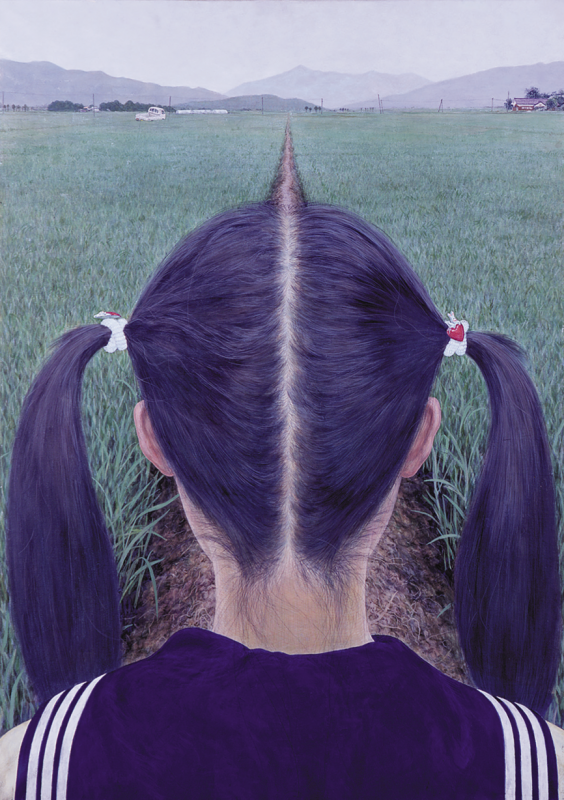
Makoto Aida, “AZEMICHI (a path between rice fields),” 1991. Japanese mineral pigment, acrylic on Japanese paper mounted on panel, 73 x 52 cm. Collection of Toyota Municipal Museum of Art, Aichi.
Prime Minister Shinzo Abe has recently revived Japan’s old nationalist crap and this has obviously angered China and Korea with whom Japan shares a contentious past. I remember you have touched upon this subject with Beautiful Flag.
Beautiful Flag is more a reflection on the idea of relativity. The idea came to me during a trip to Korea. I’d heard somewhere that many people in Korea considered the Japanese flag un-cool, while for us it is, in its simplicity, the epitome of sophisticated design. This in turn reminded me of another episode involving Korea. When I first came to Tokyo to study at a preparatory school, I spotted a girl on the train wearing an unusual school uniform. I commented loudly to my friend, saying “What a funny outfit, it’s cute!” My friend’s face went blue and he said “Shut up!” I later realized it was a Korean school uniform. I’d never seen something like that back home, and I was puzzled by my friend’s squeamish reaction. After all I knew nothing about the difficult relationship between the two countries. Anyway, to make a long story short, I decided to address the problem, even because at the time Japan and Korea were preparing to co-host the 2002 soccer World Cup and there were a lot of recriminations on both sides.
You have devoted a whole series of paintings to war-related topics, haven’t you?
Yes, I made War Picture Returns in a three-year span. During the Pacific War artists were forced to support the military effort and I was interested in this side of artist creation. At the same time, I wasn’t convinced I should comment on war as something good or bad. In fact, when you look at the whole series it’s pretty hard to see a unified story. That’s because I wasn’t trying to convey a single message. I wanted to give the impression of chaos where it’s difficult to draw a line between good and evil.
In this series you have mixed acrylic colors, photocopy on holographic paper and collage with more traditional art materials like mineral pigments. Is this another example of your fascination with old Japanese art?
In part it is. On the other side, though, it was just a matter of making do with what materials I had around. For example, the house where I was living at the time was so old it threatened to fall apart, but there were a lot of spare fusuma (thick-papered sliding doors) that I was free to use. In those days I had virtually no money, so I used them instead of canvases.
Some of the works in this series are very graphic. Gateball (1999), for instance, depicts a group of old men and women playing croquet using the severed heads of children from different Asian countries, while A Picture of an Air Raid on New York City (1997) shows a storm of Zero fighters flying over a burning Manhattan.
The idea for these paintings had been spooking around in my head for some time, but it took a while before I started working on them. As a kid I liked those scary documentary programs that NHK [Japanese public broadcaster] aired around August 15 [anniversary of the end of the Pacific War] and in junior high I had a slightly leftish attitude that made me spend hours on end at bookstores reading books on such topics as the Nanjing Massacre. Western contemporary artists, like Anselm Kiefer, often address political or historical themes, but in Japan it’s very rare. That’s perhaps because Japanese art is based on a “beauty of nature” kind of philosophy, I don’t know. The fact is, though, that we Japanese never talk about this even in our daily conversations. So many think it’s inappropriate to create artworks that reflect a particular point of view. That’s one of the things that stirred me in that direction.
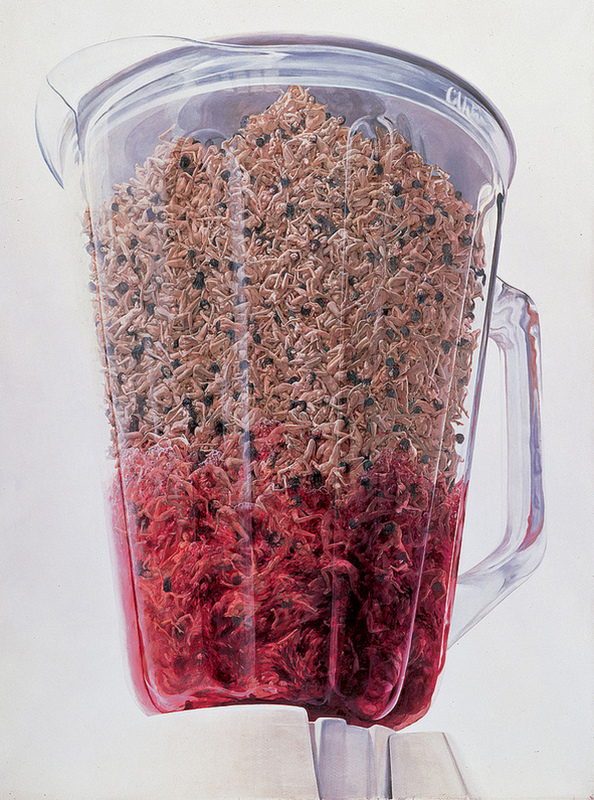
Makoto Aida, “Blender,” 2001. Acrylic on canvas, 290 x 210.5 cm. TAKAHASHI collection, Tokyo. Courtesy of the artist.
In a sense these pictures are quite shocking.
I guess so, but once again, more than the war, it has to do with my ideas revolving around Japanese-style painting. I had just finished graduate school and I was trying to connect traditional art to contemporary art. Matazo Kayama’s A Thousand Cranes was based on the Rinpa style of painting. I wanted to make something out of it, and I had this sudden idea of turning the cranes into Zero fighter planes. Now, what could be a suitable target for those planes? New York, of course! The streets of New York are arranged in a grid like those of Kyoto, so I only had to follow Japanese traditional style and add an inferno of flames . . . Perfect!
So it had to be New York, right? This was in 1996 so many people took it like you had predicted 9/11.
It’s true it could have been Paris or London . . . But I felt it had to be New York. Actually after 9/11 happened I began to think there might be something in New York’s iconic image that prompted Bin Laden to choose it as his target. We may have had the same idea after all. The difference being, of course, that my work was nothing but an attempt at black humor.
You have actually impersonated Bin Laden in one of your videos. That was fun.
Right after 9/11 several friends told me, “You look a little bit like Bin Laden, don’t you?” So I made this video as a side job, so to speak, without thinking too much about it, but it turned out to be quite popular and has been included in many exhibitions. I tried to express my sympathy to and sense of disconnection from the Middle East as well as show the mental distance between the tense international situation at the time and my peaceful life in Japan.
How do you relate to other mid-career artists of your generation, like Yoshitomo Nara and The Group 1965, or the younger-generation artists around you, like ChimạPom?
I do take some interest in other artists of my own age group who made their debuts in the early 1990s, though it might be a little inaccurate to describe us as anything like comrades. Well, maybe it could be said that I recognize them as being of the same vintage as me. I suppose you could say there’s some sense of comradeship. Even so, I don’t know much about the artists who are now active overseas, and I don’t go to documenta or the Venice Biennale. As for the younger artists around me, they don’t seem to share my tastes. Not only are they not interested in using finely pointed brushes to inscribe painstakingly detailed outlines, if anything they go out of their way to avoid it. About the only thing we seem to have in common, in fact, is that we all like booze (laughs).

Makoto Aida, “Blender,” 2001 (detail). Acrylic on canvas, 290 x 210.5 cm. TAKAHASHI collection, Tokyo. Courtesy of the artist.
Compared to other artists of your generation, you have been a sort of late-comer. I guess [gallerist] Takahashi has played an important role in your career.
Yes, for a certain period, Mr. Takahashi was my financial benefactor and he has helped me boost my profile. I wish there were more people like him who buy young artists’ works. Not like those “second class” collectors who only invest in risk-free in works of art with s certain value. If there were more people like him, more young artists would be motivated to be more creative instead of following the latest trend.
Speaking of young and old, you have been working quite a lot with students, especially on the Monument for Nothing II project, which you’re putting together from cardboard.
It came initially out of a request I received from an art college to do a workshop in a large exhibition space. The project emerged from my contemplation of what I might be able to do if I undertook a workshop with students. Actually, it’s something that demands a lot of perseverance. At the beginning we started out with a large number of people, but the students who have stuck with it and are still there at the end are very few. Those who’ve stayed the course are all silent types, who generally get on with their tasks without saying much at all. Deep down, I’m the silent type as well, so as we’re nearing the end of the project, we’re laboring away dispassionately in a deathly quiet space. There’s no need for verbal communication, in a good way. I don’t know if the students who’ve stayed with it to the end will become artists or not, but they’re all capable of perseverance so I’m sure they’ll succeed at something. They’re totally different from the noisy types who like to be the center of attention. I didn’t plan it that way, but it’s interesting how it’s turned out.
I find it interesting that you decided to put Kawaguchi Lake Mandala at the very end of your retrospective exhibition. I understand that was the oldest work on display.
Yes, I made it in 1987, when I was in my third year of university.
I read somewhere that you are particularly fond of that work for it helped solidify your artistic perspective.
One of the reasons I became the artist I am right now comes from an experience I had around that time, and this piece came from that. It let me put some things behind me and keep some things with me all the way to today. That’s why this is a really important piece of art for me.
Can you tell me about that experience?
It’s nothing special in itself. During the summer holidays, I went on a late night drive with a couple of friends. One of them had just got his driver’s license and had a poor sense of direction, so we nearly got lost near Lake Kawaguchi at the foot of Mount Fuji. I was in the rear seat, and as we drove up a mountain path that seemed endless, I was looking at the dead darkness outside the window with a vague sense of anxiety. Somehow I suddenly felt I was going to die. For some unknown reason I was having a strange feeling, and finally I realized I understood all about the universe. I hadn’t taken any drug nor was I drunk, mind you. It’s just that I was grinning like an idiot the whole time, scaring the other two guys in the car. I felt that, if I had died in an accident during that drive, my life would have become a perfect one. But artists are the kind of people who can’t just enjoy their experiences, so I started writing down the memory. I ended up with a mostly unintelligible text. It was just about time to start making works for the autumn school festival, and I decided to turn that uncanny experience into a work. But I just didn’t know how to turn those elusive thirty minutes into an artwork, especially with the help of my rambling memo. I almost gave up many times, but eventually I came up with the idea of using a mandala, for it is said to show the structure of the universe. For example, one of the phrases I had written said, “The universe is not particularly happy or sad,” so I alternated laughing and weeping faces. I knew it was too easy, or just nonsense, but it was always better than expressing nothing. It was also the beginning of my inclination for appropriating traditional styles whenever I meet some difficulty (laughs).
So you ended up displaying your mandala at the school festival?
Yes, and I now think it’s the most important work of my student days. Or better yet, this is my best work on an essential level, and my worst on a superficial one. Because of this, I can still now paint a mere “painting” without hesitation and am free of the temptation to incorporate philosophy or other lofty thoughts into my work. I intentionally changed my style after exhibiting this work. Since then I’ve followed the motto that art doesn’t deal with the essence of things, but just their surface. But I still have a special affection for it, perhaps because that night was probably the last moment of my youth.
